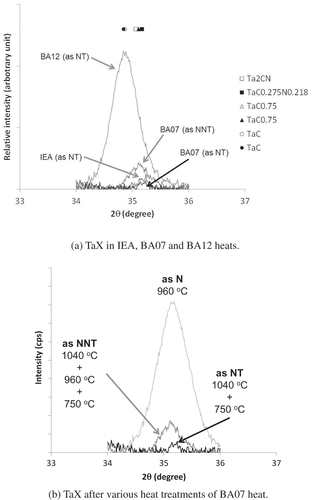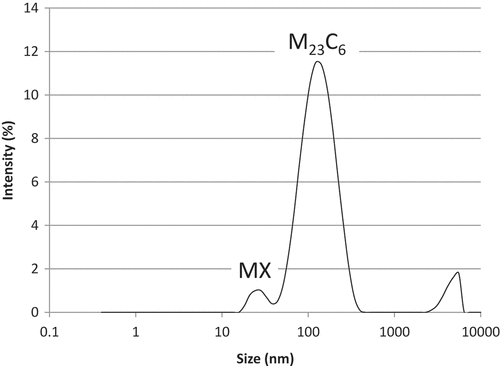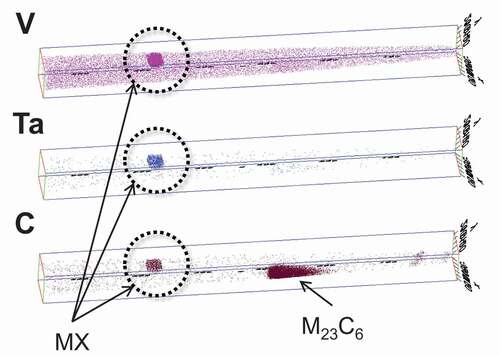ABSTRACT
Reduced activation ferritic/martensitic steels (RAFMs) have been developed for the structural material of fusion reactor blanket. Extensive researches were conducted using transmission electron microscopy (TEM) to define the precipitation behavior of MX (M: Metallic elements, X: C and/or N) precipitates such as vanadium and tantalum carbides and/or nitrides, since they strongly affect material properties. However, it is not completely defined yet. TEM can obtain detailed information, but the observable volume is limited and it needs a long time to obtain representative and statistically reliable microstructural information. It is fruitful to complement TEM results applying other characterization techniques together. In this work, we studied the precipitation behavior of MX in the RAFM, F82H, through the application of various techniques with larger observable volumes and compared with TEM past results. We additionally tried to find sub-nanometric MX precipitates that can be hardly observed through TEM. From the result, the TaX (X: C and/or N) phase surely varied depending on the chemical composition of alloy and heat treatment; some TaX precipitates were unstable during tempering, MX precipitates were intergranular, and sub-nanometric MX were not found in the matrix. These obtained results were helpful to define the precipitation behavior of MX in F82H.
1. Introduction
Reduced activation ferritic/martensitic steels (RAFMs) will be used for the structural material of ITER test blanket and DEMO blanket modules. The material properties correlate with their microstructures and much research has been conducted focusing on the precipitation behavior of fine precipitates like MX (M: Metallic elements, X: C and/or N) such as vanadium and tantalum carbides and nitrides. This results from the addition of vanadium and tantalum strongly affecting their high temperature mechanical property, material toughness, and irradiation resistance. RAFMs have been developed since the middle 1980s, based on the Mod. 9C-1Mo steel, one of the heat-resistant 9Cr Ferritic/Martensitic steels (9Cr FMs). 9Cr FMs contain vanadium and niobium forming MX precipitates and have superior creep properties [Citation1–Citation14]. In RAFMs, niobium is replaced with tantalum to reduce long-term activation [Citation15–Citation21]. Although extensive researches have been conducted, mainly using transmission electron microscopy (TEM), the role of MX precipitates in the strengthening mechanism is not yet completely understood. This situation is summarized in from representative reports of MX precipitate characterization. There is no consensus yet about their phases and preferred location, and quantitative analysis results are limited. TEM has been used in most of these researches and it is a very useful characterization technique to observe nanometric phases like MX precipitates in detail. However, the TEM observable volume is limited and it usually needs a long time to obtain representative and statistically reliable microstructural information, and sub-nanometric precipitates cannot be reliably detected. Consequently, it is very fruitful to complement the microstructural information obtained through TEM with the results obtained through other techniques with larger observable volumes and finer spatial resolutions. The combined information may allow completely understanding the role of MX precipitates. In the case of F82H, the information about the precipitation behavior of MX is not still adequate compared to 9Cr FMs and the other RAFMs. In particular, TaX (X: C and/or N) is interested MX, because tantalum is added as the element alternative to niobium in RAFMs and researches on its precipitation behavior are limited.
Table 1. Reports of MX precipitates characterization in steels
In this work, we have studied the precipitation behavior of MX precipitates in F82H particularly focusing on TaX through the application of various techniques to accumulate and complement the description of MX precipitates such as their phase, stability during heat treatment, distribution, size, and the possibility of sub-nanometric precipitation. Obtained results were then compared to some TEM past results. This expanded knowledge will contribute to the clarification of strengthening mechanisms.
2. Experimental
Field Emission Gun Electron Probe MicroAnalysis (FE-EPMA) was used to observe the distribution of MX precipitates in a much larger area about 100 × 100 (μm) with a step size of 0.24 (μm) to give representative and reliable information. Chromium Kα and vanadium Kα fluorescent X-ray signals were analyzed with the analyzing crystal of lithium fluoride (LIFH) and tantalum Mα fluorescent X-ray signal was analyzed with the analyzing crystal of thallium acid phthalate (TAP), as these signals correspond to the M23C6 precipitates (M: mainly chromium) and MX (M: vanadium and/or tantalum), which are the known precipitates in F82H. The elemental maps can show the location of these precipitates.
Field Emission Gun Scanning Electron Microscopy (FE-SEM) was also used to gather the microstructural information with a finer spatial resolution than FE-EPMA without much reducing the observable area. In some cases of higher magnifications in FE-SEM, obtained images can be comparable to TEM images. Characteristic contrast can be additionally obtained flexibly utilizing secondary and backscattered electron detectors such as inlens energy selected backscatter and angular selective backscattered detectors [Citation22], and precipitates with tens of nanometers can be observed even at lower acceleration voltages. Specimens for both EPMA and SEM observations were polished using abrasive paper and then finished to a mirror surface using colloidal silica.
X-ray diffraction (XRD) and dynamic light scattering (DLS) analyses of electrochemically extracted residue were performed to identify the phase of MX and obtain the size distribution, respectively. This information on precipitation behavior can be obtained with high reliability and representative of the bulk material through the electrochemically extracted residue analyses [Citation23], because the precipitates analyzed were electrochemically extracted from a specimen volume of ≈5 × 10−8 (m3), which is a few billions times larger than the observable volume in TEM. In this work, silicon powder of NIST (National Institute of Standards and Technology) standard reference material 640d was used in the XRD analyses to obtain appropriate reliability. DLS was applied and first used on F82H to obtain the precipitate size distribution. This technique focuses on the diffusion of particles moving under Brownian motion, and converts it to a size distribution using the Stokes–Einstein relationship. Its measures sizes in the range from 0.3 nm to 10 μm and the size distribution can be obtained in a very short time about few minutes [Citation24]. In general, TEM needs a much longer time about several hours for the statistically reliable result of size distribution. In this work, the electrochemically extracted residue was dispersed in a solution of purified water with 0.2 wt% sodium hexametaphosphate and then analyzed using a Malvern Zetasizer Nano ZS [Citation24].
The possibility of sub-nanometric precipitation was evaluated by atom probe tomography (APT). Although the observable volume is much smaller than TEM, APT allows observation of very fine precipitates, which cannot usually be observed through TEM. This analysis was performed at the FUGEN Decommissioning Engineering Center of Japan Atomic Energy Agency (JAEA). The detailed experimental information was given in the article by K. Nogiwa et al. [Citation25].
shows the chemical compositions and heat treatment conditions of the F82H steel heats studied in this work. The International Energy Agency (IEA) heat is the standard heat subjected to the round robin test performed through IEA activity. BA07 heat was developed through ITER Broader Approach (BA) activity and in this heat electro slag remelting was first used in making F82H for removing inclusions and obtaining a more homogeneous microstructure. The second normalizing was performed to improve material toughness, because TaX precipitates during the second normalizing refines austenite grains. BA12 heat was the first heat melted in a 20 tons electric arc furnace and the tantalum content was increased to reduce the susceptibility to fluctuations in the heat treatment conditions. Details of these heats were reported previously [Citation26].
Table 2. Chemical composition and heat treatment of F82H
3. Results and discussion
3.1. Phase of TaX
(a) shows the result of XRD analysis of electrochemically extracted TaX residue in IEA, BA07, and BA12 heats. In the figure, ‘as NT’ means the performed heat treatment conditions of normalizing and tempering, and ‘as NNT’ means those of double normalizing and tempering. The phases of TaX in F82H varied depending on the tantalum content and heat treatment condition. Nonstoichiometric compounds and carbonitrides were identified in addition to stoichiometric TaC. It is generally hard to measure lattice parameter in electron beam diffraction pattern of TEM more exactly than XRD and it needs a longtime statistically reliable information through many analyses on precipitates. In the obtained result, TaX phases were precisely identified with higher reliability derived from the much larger observable volume. This information is helpful to confirm TEM results from focused and limited observation areas.
3.2. Stability of TaX during heat treatment
(b) precisely shows the phase stability of TaX in BA07 heat during various heat treatments. The highest and widest peak was obtained in the specimen normalized at 960°C, but no peaks of TaX were found for the normalizing temperature of 1040°C [Citation23]. This TaX precipitation behavior can be properly interpreted by the solubility curve of TaC [Citation23]. It should be noted that TaX precipitates formed during normalizing at 960°C were possibly unstable and dissolved during tempering. The ‘as NNT’ specimen showed a much lower peak with tempering, though it is supposed that more TaX precipitated during the second normalizing at 960°C. TaX precipitates have been considered to have no significant changes at temperatures lower than normalizing temperature, but the obtained result indicated that phase, quantity, and size changed. This is because its position, height, and width of peak obviously changed at 750°C tempering temperature. Tamura M, et al. also reported changes in precipitation behavior of TaC during tempering and mentioned that discontinuous microstructural developments during tempering such as generation of sub-grains can possibly affect the dissolution and re-precipitation [Citation27], which can support the obtained result in this work. The result of XRD analysis of electrochemically extracted residue is helpful information to TEM in order to define the precipitation behavior.
3.3 Distribution of MX precipitates
(a), (b), and (c) show the result of FE-EPMA elemental mapping of IEA, BA07, and BA12 heats (as NT), respectively, in addition to their backscattering electron images (BEIs). Their magnification is lower than the usual magnification of TEM, but their observable area is large and about 100 × 100 (μm). The observation result of large observable area gives helpful information to define the characteristic and representative microstructure before the observation with higher magnifications. In the result of IEA heat, a large particle with few micrometers in size was observed and it was identified as inclusion [Citation28]. Vanadium and tantalum signals, which are main elements in MX precipitates, tend to be found decorating grain and sub-grain boundaries like intergranular M23C6 which emit chromium signal, and their signals were hardly detected inside the matrix. This result supposes that MX precipitates are intergranular. shows the result of elemental mapping with higher magnifications focusing on grain and sub-grain boundaries of a F82H. Vanadium and tantalum signals were not homogeneously detected in the matrix, but on the grain and sub-grain boundaries in (a). MX precipitates less than 50 nm can be detected in (b) and their size is comparable to the reported sizes in . This result can also support that MX precipitates are intergranular. Other FE-EPMA results [Citation23,Citation26] and the following result shown in [Citation29] also support that MX precipitates are intergranular. In this figure, BA10 heat (0.04% Ta) has the chemical composition to comparable to BA07 heat and T10LN heat (0.10% Ta) has higher tantalum like BA12 heat. Precipitates can be more clearly observed with a higher spatial resolution of FE-SEM. Precipitates show brighter contrast, because M23C6 and MX contain heavier elements like tungsten and tantalum than iron of the matrix, respectively [Citation19]. Bright contrast areas with sizes larger than about 100 nm correspond to M23C6 precipitates and those with sizes less than about 50 nm correspond to MX precipitates. The bright contrast can be mainly found on grain and sub-grain boundaries. On the other hand, few bright contrasts can be also seen in the matrix, but they are not uniformly found and seem aligned, as found inside dotted circles in . It can be assumed that such aligned MX particles possibly precipitated on a lath boundary, but they remained in the matrix during the microstructural recovery through tempering. There is no homogeneous distribution of fine precipitates in the matrix which contributes to the Orowan strengthening mechanism. Some TEM results of RAFMs also support this obtained result [Citation18,Citation19]. However, some other TEM results discrepantly report that MX particles were found in the matrix, as shown in . This means that it is important to continue accumulating TEM results and complementarily perform other characterization techniques with larger observable volumes together, but MX precipitates were considered to be intergranular in F82H and not uniformly distributed in the matrix. The result means that the Orowan strengthening mechanism by MX precipitates can be hardly expected, although this has been considered the most likely mechanism for the improvement of high temperature mechanical properties. From the result of this work, it can be assumed that intergranular MX precipitates mainly contribute to stabilizing the martensitic lath structure at high temperatures which improves the creep property, as already discussed in some reports of 9Cr FMs [Citation9,Citation13].
Figure 2. FE-EPMA elemental mapping: acceleration voltage 15 kV. (a) IEA heat (as NT); (b) BA07 heat (as NT); (c) BA12 heat (as NT).
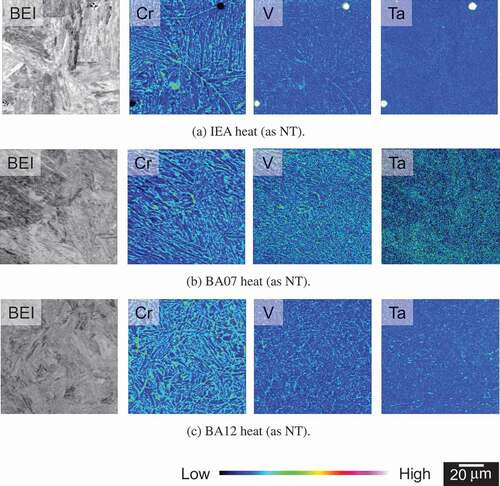
Figure 3. FE-EPMA elemental mapping on grain and sub-grain boundaries. (a) Grain and sub-grain boundaries: acceleration voltage 10 kV; (b) enlarged boundary: acceleration voltage 30 kV.
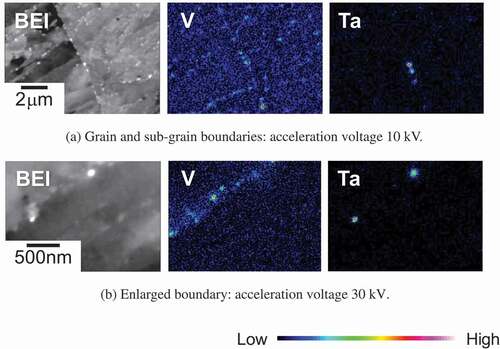
Figure 4. FE-SEM BEI image [Citation29]. (a) BA10 heat (0.04% Ta): acceleration voltage 4 kV, angular selective backscattered detector; (b) T10LN heat (0.10% Ta): acceleration voltage 5 kV, angular selective backscattered detector.
![Figure 4. FE-SEM BEI image [Citation29]. (a) BA10 heat (0.04% Ta): acceleration voltage 4 kV, angular selective backscattered detector; (b) T10LN heat (0.10% Ta): acceleration voltage 5 kV, angular selective backscattered detector.](/cms/asset/5230ead7-9d64-421f-af9e-bf6656328582/tnst_a_1483845_f0004_b.gif)
3.4. Possibility of sub-nanometric MX precipitation
In past research, the observed size of MX was several tens of nanometers and their number densities were between 1017 and 1019 (m−3) orders of magnitude, as shown in . However, there is the possibility that finer precipitates form with sub-nanometric sizes which can usually not be observed by TEM. shows a representative size profile obtained through DLS on the electrochemically extracted residue of BA07 heat (as NNT). It should be noted that the minimum detectable size by DLS analysis is 0.3 nm and sub-nanometric-sized precipitates can be measured. In the figure, three peaks were found corresponding to MX, M23C6, and agglomerated precipitates that were identified basing on characterization results obtained from other techniques such as FE-EPMA in and TEM [Citation19]. Sub-nanometric-sized precipitates were hardly found. Scattered intensity relates to particle volume and volume fraction can be calculated, but the result of DLS analysis on finer particles is sensitive to larger particles like agglomerated precipitates and the signal from finer particles is hardly detected without an appropriate condition of particle dispersion. When aggregated particles are reduced or removed, it is possible to improve reliability and repeatability of DLS analysis. Though it is important to modify the condition for the more improved reliability and repeatability in the analysis of finer particles, the obtained size profile showed good agreement with the other results and DLS analysis could be an useful technique to obtain size profile of nanometric and sub-nanometric precipitates from a much larger sample volume in a much shorter time.
We also tried to perform APT on the BA07 heat specimen normalized at 980°C for 60 min and tempered at 750°C for 60 min to examine the possibility of the presence of sub-nanometric precipitates. TaC surely precipitates at the normalizing temperature [Citation23]. It is well recognized that APT is the most useful technique to observe very fine precipitates, less than a few nanometers, though the observable volume is very limited. We analyzed C+, C2+, V2+, Ta3+, Ta2+, and TaC3+ ions in the mass spectrum to find sub-nanometric precipitates. The total count number of tantalum was lower than that of vanadium, but tantalum generally forms MX precipitates together with vanadium and MX can be observed more clearly in vanadium image than in tantalum image. shows the APT result imaging vanadium, tantalum, and carbon. A single MX particle was found and its diameter was about 30 nm. The other larger contrast of carbon image was identified as M23C6 through its mass spectrum analysis. Sub-nanometric precipitates were hardly found through all APT observations of this work, though it is important to continue further examination for the statistic reliability and the quantitative information of chemical composition. The total observed volume of the needle specimens was about 10−20 (m3) and the number density of MX was assumed to be at least less than the order of magnitude of 1020 (m−3). This number density is consistent with the past reported results in . This result supports that there is no uniform precipitation of MX in the matrix and the Orowan strengthening can be hardly expected, as supposed in the former section of 3.3.
4. Conclusion
We have characterized MX precipitates in F82H using various techniques with larger observable areas/volumes and APT with a finer spatial resolution, and obtained the following results which have been hardly obtained through TEM observation. The application of various techniques was useful and helpful to completely define the precipitation behavior of MX.
XRD analysis on electrochemically extracted residues revealed that TaX phase surely varied depending on alloy composition variations. Non-stoichiometric TaC, TaN, and Ta (C, N) were identified in addition to stoichiometric TaC. This has been hardly found only through TEM observations.
XRD analysis on electrochemically extracted residues indicated that TaX precipitated during normalizing was unstable during tempering. This has been hardly found only through TEM observations.
FE-EPMA and SEM observations on much larger areas than TEM observations revealed that MX precipitates in F82H were not homogeneously observed in the matrix and they were rather intergranular. The minimum observable size of MX was a few tens nm and comparable to the size observed in TEM observations.
DLS analysis was applied to F82H as a new technique to obtain the size profile of electrochemically extracted residue. The result was obtained within shorter time about few minutes and showed a good agreement with the other results. Though it is still necessary to modify the condition for more improved reliability and repeatability through further works, it is a promising technique for size distribution of precipitates.
APT revealed that the diameter of MX was larger than a few tens nm and the number density was at least less than ~1020 (m−3). No finer MX particles were found.
In the case of F82H, Orowan strengthening mechanism is unlikely and it is important to focus the role of intergranular MX precipitates to completely clarify the strengthening mechanism. This can be confirmed through FE-EPMA and SEM observations on larger areas than TEM observations.
Acknowledgments
The work of DLS was supported by Japan Society for the Promotion of Science (JSPS) Grant-in-Aid for young scientists (B) [Number 23760676] (KAKENHI). The authors would like to acknowledge the assistance by K. Nogiwa, M. Makino, and T. Nakamura of JAEA to their experimental APT work and support.
Disclosure statement
No potential conflict of interest was reported by the authors.
References
- Vitek JM, Klueh RL. Precipitation reactions during the heat treatment of ferritic steels. Metall Trans A. 1983 Jun;14A:1047–1055.
- Maziasz PJ, Klueh RL, Vitek JM. Helium effects on void formation in 9Cr-1MoVNb and 12Cr-1MoVW irradiated in HFIR. J Nucl Mater. 1986 Nov-Dec;141–143:929–937.
- Kai JJ, Klueh RL. Microstructural analysis on neutron-irradiated martensitic steels. J Nucl Mater. 1986 Jun;230:116–123.
- Sawada K, Kubo K, Abe F. Creep behavior and stability of MX precipitates at high temperature in 9Cr–0.5Mo–1.8W–vNb steel. Mat Sci Eng. 2001 Dec;319–321:784–787.
- Maruyama K, Sawada K, Koike J. Strengthening mechanisms of creep resistant tempered martensitic steel. ISIJ Int. 2011 Jun;41:641–653.
- Hashimoto N, Klueh RL. Microstructural evolution of nickel-doped 9Cr steels irradiated in HFIR. J Nucl Mater. 2002 Oct;305:153–158.
- Sawada K, Hara T, Kubo K, et al. Characterization of MX distribution in P92 steel by EF-TEM. Proc. First International Conference on Advanced Structural Steels; 2002 May 22–24; Tsukuba (Japan). p. 179–180.
- Suzuki K, Kumai S, Kushima H, et al. [Precipitation of Z-phase and precipitation sequence during creep deformation of mod. 9Cr-1Mo steel]. In Japanese. Tetsu-to-Hagané. 2003 Jun;89:691–698
- Taneike M, Abe F, Sawada K. Creep-strengthening of steel at high temperatures using nano-sized carbonitride dispersions. Nature. 2003 Jul;424:294–296.
- Klueh RL, Hashimoto N, Maziasz PJ. Development of new nano-particle-strengthened martensitic steels. Scr Mater. 2005 Aug;53:275–280.
- Sawada K, Miyahara K, Kushima H, et al. Contribution of microstructural factors to hardness change during creep exposure in mod. 9Cr-1Mo steel. ISIJ Int. 2005 Dec;45:1934–1939.
- Klueh RL, Hashimoto N, Maziasz PJ. New nano-particle-strengthened ferritic/martensitic steels by conventional thermo-mechanical treatment. J Nucl Mater. 2007 Aug;367–370:48–53.
- Chen RP, Ghassemi Armaki H, Yoshimi K, et al. [Premature creep rupture and overestimation of rupture life in modified 9Cr–1Mo steel]. In Japanese. Tetsu-to-Hagané. 2010 Sep;96:564–571
- Sawada K, Kushima H, Hara T, et al. Heat-to-heat variation of creep strength and long-term stability of microstructure in Grade 91 steels. Mater Sci Eng, A. 2014 Mar;597:164–170.
- Klueh RL, Maziasz PJ. The microstructure of chromium-tungsten steels. Metall Trans A. 1989 Mar;20A:373–382.
- Jayaram R, Klueh RL. Microstructural characterization of 5 to 9 pct Cr-2 pct W-V-Ta martensitic steels. Metall Mater Trans. 1998 Jun;29A:1551–1558.
- Klueh RL, Alexander DJ, Sokolov MA. Effect of chromium, tungsten, tantalum, and boron on mechanical properties of 5–9Cr–wVTaB steels. J Nucl Mater. 2002 Aug;304:139–152.
- Klimenkov M, Lindau R, Matema-Morris E, et al. TEM characterization of precipitates in Eurofer 97, Prog. Nucl Energ. 2012 May;57:8–13.
- Fukumoto K, Sakaguchi T, Inoue K, et al. Dependence of precipitate formation on normalizing temperature and its impact on the heat treatment of F82H-BA07 steel. J Nucl Mater. 2013 Nov;442:S28–S32.
- Kano S, Yan HL, Suzue R, et al. Precipitation of carbides in F82H steels and its impact on mechanical strength. Nucl Mater Energy. 2016 Dec;9:331–337.
- Tamura M, Hayakawa H, Tanimura M, et al. Development of potential low activation ferritic and austenitic steels. J Nucl Mater. 1986 Nov-Dec;141–143:1067–1073.
- Carl zeiss microscopy GmbH. Available from: https://www.zeiss.com/content/dam/Microscopy/Products/electron-microscopes/upgradesEM/pdf/upgradeinfo-asb-detector.pdf
- Sakasegawa H, Tanigawa H, Kano S, et al. Precipitation behavior in F82H during heat treatments of blanket fabrication. Fus Eng Des. 2011;86:2541–2544.
- Malvern. Available from: https://www.malvernpanalytical.com/en/products/product-range/zetasizer-range/zetasizer-nano-range/zetasizer-nano-zs
- Nogiwa K, Onitsuka T, Abe T, et al. Influence of thermal aging on cast stainless steels used in JAEA’s nuclear reactor fugen. J Nucl Sci Technol. 2013 Sep;50:883–890.
- Sakasegawa H, Tanigawa H, Kano S, et al. Material properties of the F82H melted in an electric arc furnace. Fus Eng Des. 2015 Oct;98–99:2068–2071.
- Tamura M, Kusuyama H, Shinozuka K, et al. Tempering process and precipitation behavior of 8%Cr–2%WTa steel. ISIJ Int. 2007 Feb;47:317–326.
- Tanigawa H, Sawahata A, Sokolov MA, et al. Effects of inclusions on fracture toughness of reduced-activation ferritic/martensitic F82H-IEA steels. Mater Trans, JIM. 2007 Mar;48:570–573.
- Hamaguchi D, Tanigawa H, Sakasegawa H, et al. Investigation of precipitate behavior on F82H ferritic steel using hi-resolution X-ray spectrometer. The Japan Institute of Metals and Materials. Autumn annual 149th meeting; 2011 Nov 7–9; Ginowan (Japan).

